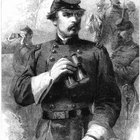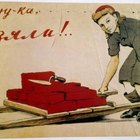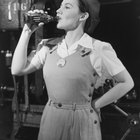
Preconceived notions of gender roles from the 19th Century continued well into that of the 20th Century. The Industrial Revolution placed women in roles of domesticity, while men earned wages and supported families. Toward the middle of the century, these roles became less defined, although women continued to work in subordinate positions and for less pay
Work
At the beginning of the 20th Century, middle class families were largely composed of one income-earner, the male. Economic programs known as the New Deal, implemented between 1933 and 1936, further supported this structure. By 1940, however, the burdens imposed by war forced many families to collectively support each other. Women accepted lodgers while their men were away at war and performed sewing and laundry to supplement male wages. In the 1960s, an increasing number of married women held formal jobs and 45 percent of the total workforce in 1989 consisted of women. They worked most commonly in clerical, service and factory environments. Men, meanwhile, held decision-making positions and dominated earned wages.
Home
Up to the 19th Century, American women toiled at home to educate children, manufacture goods for general consumption and maintain farms. This enabled men to plow and harvest crops, but such roles changed with America's Industrial Revolution. Women were then free to raise children and manage the housekeeping, as men were expected for the first time to leave the homestead and earn wages. During World War II, men were called to battle lines and women forced from home to hold college seats and work. After the war, men returned home and reclaimed most jobs, thus leaving women once more to continue serving as wives and mothers. In the 1950s, women were expected to create inviting homes for men who worked all day. Not until the 1960s did females profoundly impact the workforce.
Religion and Morality
Through the late 1800s and early 1900s, women were perceived as more morally upright than men. They were thus considered to be the backbone of familial morals, and added to this was the belief that females were more religious than males. This is largely because women composed the greatest number of church attendants, although men dominated the roles of religious leaders. While women attended church, men questioned the existence of a god. This struggle was identified in the April 1949 issue of "Time" magazine with an article titled, "Where is Man?: Morals." Therein, morality was described as a relative issue, whereby one idea of right and wrong could be found as compelling as another, with no reference to women.
Politics
In the early 20th Century, women's suffrage was a pressing issue. At this time, the male-only government was believed to implement specific strategies to keep women out of the workplace, muffle their political concerns and retain them at home. One such strategy was the diminished access of birth control. After the 19th Amendment passed in 1920, women voted with their husbands and fathers, generally adhering to their beliefs because of shared concerns in social and economical matters. In the 1960s, men led protests concerning government involvement overseas and civil rights. Women also began to protest, but with different intentions because the male population collectively labeled them as inferior. Their arguments thus focused on exclusion from leadership roles and male-dominated work positions.
Related Articles

How Absent Fathers Affect Men

Traditional Roles of Men & Women in ...

Men's Roles in the 1800s

Husband & Wife Relationships in the ...

Traditional Gender Roles in Marriage

The Pros & Cons of Gender Roles

Clothing of the Children During the ...

The History of Child Care Programs

Do Muslim Women Go to Mosques?

Farmer's Wife's Clothes in the 1800s

What Experiences Make Men Emotionally ...

The Effect of Divorced Parents on a ...

Why Did Women Cut Their Hair to Become ...

List of Charitable Organizations in Ohio

Women's Clothes in 1943

The History of Converse Shoes

How to Find Date of Birth Using Social ...

Can a Man Have a Close Friendship With ...

The History of School Uniform

Shoe Sizes Explained
References
Writer Bio
Jean Miller has been writing since 2008. As a freelance writer, she has developed website content, press releases and newsletters for a variety of clients. Miller holds a Bachelor of Business Administration in human resource management from Cleary University.
Photo Credits
Jupiterimages/Photos.com/Getty Images